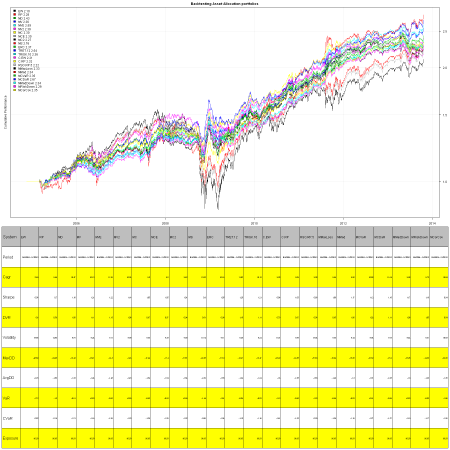Update for Backtesting Asset Allocation Portfolios post
Want to share your content on R-bloggers? click here if you have a blog, or here if you don't.
It was over a year since my original post, Backtesting Asset Allocation portfolios. I have expanded the functionality of the Systematic Investor Toolbox both in terms of optimization functions and helper back-test functions during this period.
Today, I want to update the Backtesting Asset Allocation portfolios post and showcase new functionality. I will use the following global asset universe as: SPY,QQQ,EEM,IWM,EFA,TLT,IYR,GLD to form portfolios every month using different asset allocation methods.
###############################################################################
# Load Systematic Investor Toolbox (SIT)
# http://systematicinvestor.wordpress.com/systematic-investor-toolbox/
###############################################################################
setInternet2(TRUE)
con = gzcon(url('http://www.systematicportfolio.com/sit.gz', 'rb'))
source(con)
close(con)
#*****************************************************************
# Load historical data
#******************************************************************
load.packages('quantmod,quadprog,corpcor,lpSolve')
tickers = spl('SPY,QQQ,EEM,IWM,EFA,TLT,IYR,GLD')
data <- new.env()
getSymbols(tickers, src = 'yahoo', from = '1980-01-01', env = data, auto.assign = T)
for(i in ls(data)) data[[i]] = adjustOHLC(data[[i]], use.Adjusted=T)
bt.prep(data, align='remove.na', dates='1990::')
#*****************************************************************
# Code Strategies
#******************************************************************
cluster.group = cluster.group.kmeans.90
obj = portfolio.allocation.helper(data$prices,
periodicity = 'months', lookback.len = 60,
min.risk.fns = list(
EW=equal.weight.portfolio,
RP=risk.parity.portfolio,
MD=max.div.portfolio,
MV=min.var.portfolio,
MVE=min.var.excel.portfolio,
MV2=min.var2.portfolio,
MC=min.corr.portfolio,
MCE=min.corr.excel.portfolio,
MC2=min.corr2.portfolio,
MS=max.sharpe.portfolio(),
ERC = equal.risk.contribution.portfolio,
# target retunr / risk
TRET.12 = target.return.portfolio(12/100),
TRISK.10 = target.risk.portfolio(10/100),
# cluster
C.EW = distribute.weights(equal.weight.portfolio, cluster.group),
C.RP = distribute.weights(risk.parity.portfolio, cluster.group),
# rso
RSO.RP.5 = rso.portfolio(risk.parity.portfolio, 5, 500),
# others
MMaxLoss = min.maxloss.portfolio,
MMad = min.mad.portfolio,
MCVaR = min.cvar.portfolio,
MCDaR = min.cdar.portfolio,
MMadDown = min.mad.downside.portfolio,
MRiskDown = min.risk.downside.portfolio,
MCorCov = min.cor.insteadof.cov.portfolio
)
)
models = create.strategies(obj, data)$models
#*****************************************************************
# Create Report
#******************************************************************
strategy.performance.snapshoot(models, T, 'Backtesting Asset Allocation portfolios')
I hope you will enjoy creating your own portfolio allocation methods or playing with a large variety of portfolio allocation techniques that are readily available for your experimentation.
To view the complete source code for this example, please have a look at the bt.aa.test.new() function in bt.test.r at github.
R-bloggers.com offers daily e-mail updates about R news and tutorials about learning R and many other topics. Click here if you're looking to post or find an R/data-science job.
Want to share your content on R-bloggers? click here if you have a blog, or here if you don't.

